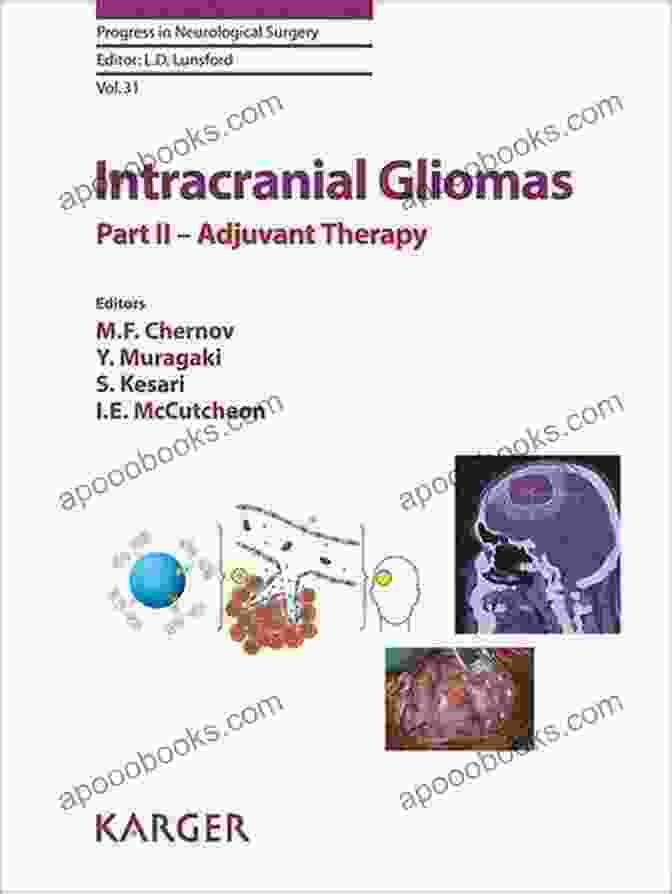Intracranial Gliomas: Part II - Adjuvant Therapy: Reshaping the Frontiers of Neurological Surgery

4 out of 5
| Language | : | English |
| File size | : | 8079 KB |
| Text-to-Speech | : | Enabled |
| Screen Reader | : | Supported |
| Enhanced typesetting | : | Enabled |
| Print length | : | 363 pages |
Intracranial gliomas, malignant tumors originating within the brain, pose a significant challenge to the field of neurological surgery. Despite advancements in surgical techniques and primary treatment modalities, the recurrence of gliomas remains a major concern, often leading to devastating outcomes for patients. To address this challenge, adjuvant therapies, administered after primary surgery, have emerged as a cornerstone of treatment strategies, offering hope for improved patient outcomes.

Radiation Therapy
Radiation therapy, a widely employed adjuvant therapy, utilizes high-energy radiation to target and destroy cancer cells. In the context of intracranial gliomas, radiation therapy is typically administered post-operatively to eliminate any residual tumor cells and reduce the risk of recurrence. Techniques such as conformal radiation therapy and intensity-modulated radiation therapy (IMRT) allow for precise targeting of the tumor while sparing surrounding healthy tissues.
Radiation therapy has been shown to improve survival rates and reduce the risk of local recurrence in patients with intracranial gliomas. However, it can also carry potential side effects, including cognitive impairment, fatigue, and hair loss. Careful patient selection and treatment planning are essential to minimize these risks and optimize therapeutic outcomes.
Chemotherapy
Chemotherapy involves the use of cytotoxic drugs to kill rapidly dividing cancer cells. In the treatment of intracranial gliomas, chemotherapy is often administered concurrently with radiation therapy or as a standalone therapy for patients who are not candidates for radiation. Common chemotherapeutic agents used include temozolomide, carmustine, and lomustine.
Chemotherapy can be effective in controlling tumor growth and improving survival rates. However, it can also lead to side effects such as nausea, vomiting, hair loss, and bone marrow suppression. The development of targeted chemotherapeutic agents, which specifically target cancer cells, holds promise for reducing the toxicity associated with conventional chemotherapy.
Targeted Therapy
Targeted therapy, a relatively recent advancement in cancer treatment, involves the use of drugs that specifically inhibit molecular targets involved in tumor growth and progression. In the case of intracranial gliomas, targeted therapies have shown great promise in improving patient outcomes.
One of the most well-established targeted therapies for intracranial gliomas is bevacizumab, which targets vascular endothelial growth factor (VEGF),a protein that promotes tumor angiogenesis. Bevacizumab has been shown to improve progression-free survival and overall survival in patients with recurrent glioblastoma.
Immunotherapy
Immunotherapy, an exciting frontier in cancer treatment, harnesses the power of the immune system to fight cancer. In the context of intracranial gliomas, immunotherapy aims to stimulate the immune system to recognize and attack tumor cells.
Several immunotherapeutic approaches are currently being investigated for the treatment of intracranial gliomas. These include immune checkpoint inhibitors, which block inhibitory molecules on immune cells, and adoptive cell therapies, which involve modifying immune cells to enhance their anti-tumor activity.
Adjuvant therapies have revolutionized the treatment of intracranial gliomas, offering hope for improved patient outcomes. Radiation therapy, chemotherapy, targeted therapy, and immunotherapy, each with unique mechanisms of action, play a vital role in controlling tumor growth, reducing recurrence, and prolonging survival.
As research continues to unravel the molecular complexities of intracranial gliomas, the development of novel adjuvant therapies holds great promise for further improving patient outcomes. Personalized treatment approaches, tailored to the individual genetic and molecular profile of each tumor, are expected to play a significant role in the future of glioma management.
The relentless pursuit of scientific advancements and the dedication of clinicians and researchers are driving the field of neurological surgery forward, offering renewed hope for patients battling intracranial gliomas.
4 out of 5
| Language | : | English |
| File size | : | 8079 KB |
| Text-to-Speech | : | Enabled |
| Screen Reader | : | Supported |
| Enhanced typesetting | : | Enabled |
| Print length | : | 363 pages |
Do you want to contribute by writing guest posts on this blog?
Please contact us and send us a resume of previous articles that you have written.
 Book
Book Novel
Novel Page
Page Chapter
Chapter Text
Text Story
Story Genre
Genre Reader
Reader Library
Library Paperback
Paperback E-book
E-book Magazine
Magazine Newspaper
Newspaper Paragraph
Paragraph Sentence
Sentence Bookmark
Bookmark Shelf
Shelf Glossary
Glossary Bibliography
Bibliography Foreword
Foreword Preface
Preface Synopsis
Synopsis Annotation
Annotation Footnote
Footnote Manuscript
Manuscript Scroll
Scroll Codex
Codex Tome
Tome Bestseller
Bestseller Classics
Classics Library card
Library card Narrative
Narrative Biography
Biography Autobiography
Autobiography Memoir
Memoir Reference
Reference Encyclopedia
Encyclopedia Stephen Tankel
Stephen Tankel Thomas Healy
Thomas Healy Steven F Viegas
Steven F Viegas Morris Fenris
Morris Fenris Wilson Ring
Wilson Ring Shameka Jones
Shameka Jones Riley Black
Riley Black Tracy Cooper Posey
Tracy Cooper Posey Timothy J O Brien
Timothy J O Brien Shanthi Kalathil
Shanthi Kalathil Taylor Snow
Taylor Snow William C Oakes
William C Oakes Rebecca Jenshak
Rebecca Jenshak Holly Chamberlin
Holly Chamberlin Robert J Morgan
Robert J Morgan Tiffany Singleton
Tiffany Singleton Robert Kumpf
Robert Kumpf Salman Ahmad
Salman Ahmad Sasa Stanisic
Sasa Stanisic Tina Rasalla
Tina Rasalla
Light bulbAdvertise smarter! Our strategic ad space ensures maximum exposure. Reserve your spot today!

 Felix HayesUnveiling the Poetic Brilliance of Robert Burns: A Journey Through Selected...
Felix HayesUnveiling the Poetic Brilliance of Robert Burns: A Journey Through Selected...
 Ervin BellRealizing Freedom: A Comprehensive Guide to Libertarian Theory, History, and...
Ervin BellRealizing Freedom: A Comprehensive Guide to Libertarian Theory, History, and... Zadie SmithFollow ·11.3k
Zadie SmithFollow ·11.3k Hudson HayesFollow ·3.8k
Hudson HayesFollow ·3.8k Oliver FosterFollow ·2.4k
Oliver FosterFollow ·2.4k Leo MitchellFollow ·15.2k
Leo MitchellFollow ·15.2k Levi PowellFollow ·19.8k
Levi PowellFollow ·19.8k Dennis HayesFollow ·11.5k
Dennis HayesFollow ·11.5k Jason ReedFollow ·18.4k
Jason ReedFollow ·18.4k Garrett BellFollow ·17.4k
Garrett BellFollow ·17.4k

 Harry Cook
Harry CookRape Blossoms and White Sky: A Floral Symphony of...
A Kaleidoscope of Colors...

 Vic Parker
Vic ParkerThe Passion of Jovita Fuentes: Unveiling the...
Immerse yourself in the...

 Cormac McCarthy
Cormac McCarthySinners and Saints: A Dark New Adult High School Bully...
Sinners and Saints is...
4 out of 5
| Language | : | English |
| File size | : | 8079 KB |
| Text-to-Speech | : | Enabled |
| Screen Reader | : | Supported |
| Enhanced typesetting | : | Enabled |
| Print length | : | 363 pages |














